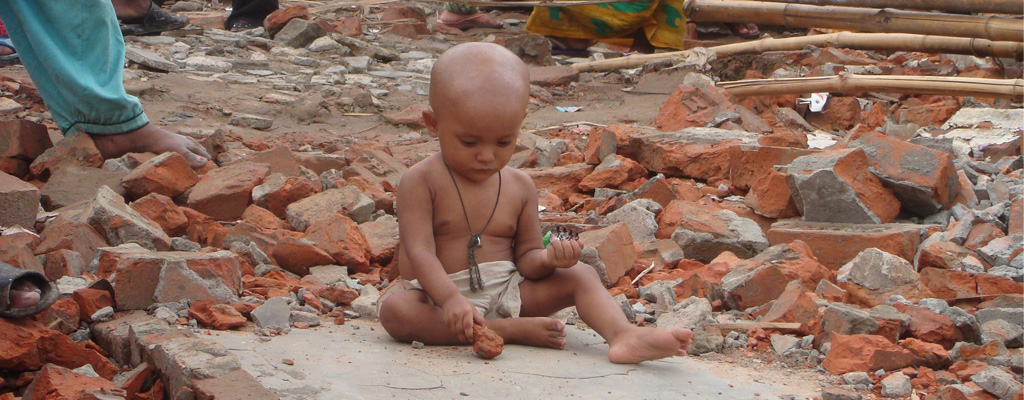“And then one morning the bulldozers were running over our homes.”
This statement is commonly heard from slum dwellers living in Dhaka city. Dhaka, the capital of Bangladesh, is one world’s most densely populated cities, having a population density of 44,500 people per square kilometre. In 2005, the city was home to 3.4 million slum residents, all living an uncertain life. Apart from struggling with barely earning a living, the greatest reason for their uncertainty is fear of forced eviction.

Each year hundreds and thousands of poor people living in Dhaka’s slums face forced displacement out of their homes. Most of these slums grew up on public and private lands and have been home to generations of poor people who migrated to Dhaka from all over the country. The eviction process is frequently violent and includes demolishing homes and physical and mental abuse to slum residents. Most of these eviction drives are either led by law enforcement groups directly or by privately hired ‘thugs’. Each drive leaves thousands of poor people to starve and sleep in the open air, and sometimes even lose the little amount of capital and asset that they earned.
In this era of discussing a sustainable future for cities; the question is ‘who decides how the city will sustain and whose voice counts?’
Forced slum eviction is one of the most commonly practiced forms of human rights violation in Dhaka, Bangladesh. During eviction drives people are forced out of their homes, beaten up, sometimes imprisoned and their belongings destroyed. Even though law enforcement groups are often seen playing a prominent role in the evictions, in most cases the victims claim they received no previous notice of eviction. This suggests that many of these violent forced evictions possibly do not follow law and regulations or human rights code. After each series of violent evictions, the city authority often comes forward with justification of acquiring the land for city development and promises of ‘relocating’ the affected slum dwellers. However, the promises rarely translate into actions; therefore the victims remain homeless for a few weeks and rebuild their temporary shacks nearby; only to wait to be beaten out of their homes again.
Asiron’s story
Asiron’s story is typical. She is a 28 year-old housemaid and was evicted from a slum in Gulshan area. In her story, published in Coping with Forced Evictions: Adaptation Processes of Evicted Slum Dwellers in Dhaka, she says:
For the last 16 years we have been living in this slum. We came here because there is a high demand for housemaids in the surrounding neighbourhoods. I am working as a housemaid in Banani [adjacent high-income area] and my husband is a construction worker. […] We were first evicted from this site in January 2007. We didn’t receive any notice before the eviction. They treated us very badly and burnt our houses. We lost all our furniture and house materials when they ran the bulldozer over our house. I was helpless. […] For four days we stayed under the open field, nobody cared for us. Then we gathered some plastic, tins and old cloths to build a temporary house in the same place, with the help of some neighbours. We have no other place to go to and we cannot risk losing our jobs. We have to stay here. […] The social networks are not as good as before, because of the constant threat of eviction there is some tension and sometimes we quarrel very badly. […] I don’t know when we will be forced out of here again.
The problem
In Dhaka city, 70 per cent of the population consists of low-income residents but they have access to only 20 per cent of the land. Hence, the 30 percent of city elites hold ownership over 80 per cent of the land. Approximately, two-thirds of Dhaka slums are located on lands privately owned by wealthy individuals. Given this vast scale of inequality and scarcity of land in this over populated city; individual owners often try to get a hold on their piece of land via the means of forced evictions. Many times lands are acquired after years of settlements growing upon them. The most common reasons for slum evictions are listed as infrastructural development, road constructions and space required for government projects.
While it may seem like the elites of the city are teaming up to displace poor people onto the streets; it is also true that the slum dwellers have no formal or legal ownership over the land where they lived for years. This shelter insecurity of a vast majority of the city population is a crucial failure on the state’s part. However, this crisis does not seem to nudge the city authorities much while forced and violent slum evictions continue to take place without having a practical rehabilitation plan in effect.
Hearing slum dwellers voices is critical for sustainable solutions
Most of the rehabilitation plans are focused on moving the evicted slum residents to the periphery of the city and hugely underestimate the numbers of evicted people; whereas, the jobs of these people are around their original slum locations. Therefore, even if they are rehabilitated as per plan, it will be an even bigger struggle for them to find jobs in those areas or to commute to their job locations every day. By ignoring the voice of a key stake holder like slum residents, the city planning and policies are not only being constructed in a faulty manner but also are set to make the city condition worse than any better. Therefore, in order to truly work towards creating sustainable and liveable cities, making the voices of urban poor a part of forming city plans and policies is vital.
Tanjila Mazumder Drishti is a Bangladeshi development practitioner and social activist who recently graduated from IDS with an MA in Globalisation, Business and Development.
